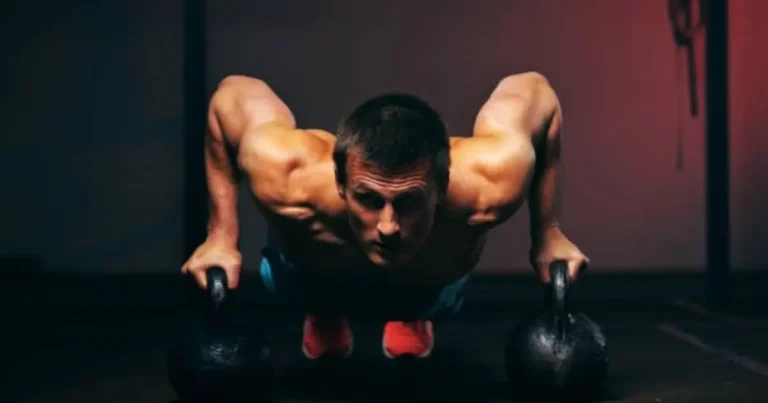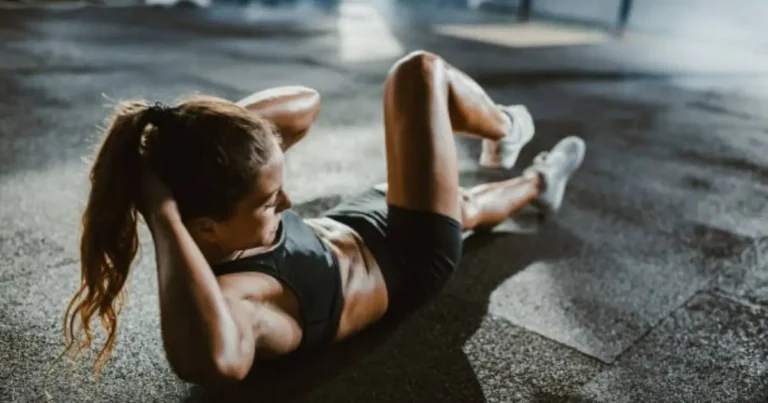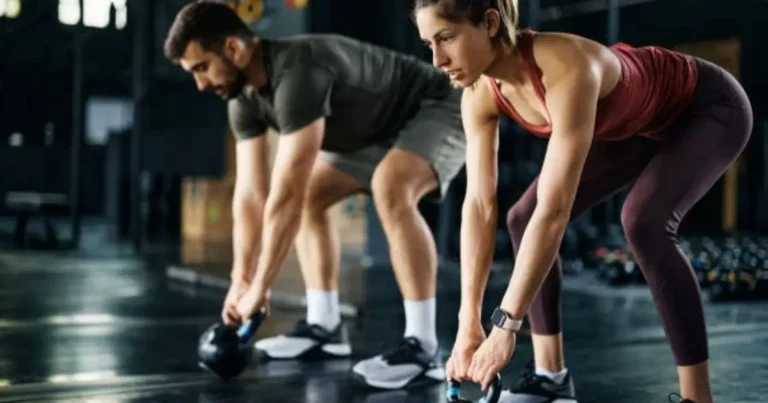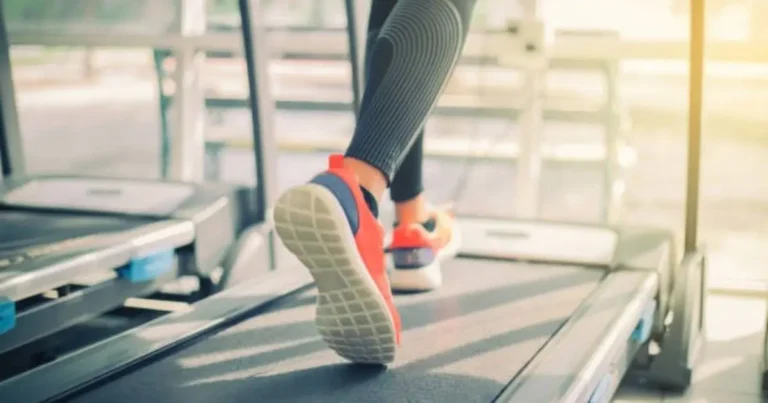The Ultimate Guide to Bench Ab Workouts: Sculpt Your Six-Pack
When it comes to achieving a defined and toned midsection, many people think of traditional sit-ups and crunches. However, incorporating bench ab workouts into your fitness routine can help you target your core in new and effective ways. Whether you’re looking to build a stronger core, improve posture, or get that coveted six-pack, using a bench for ab exercises can take your training to the next level.
In this comprehensive guide, we’ll explore everything you need to know about bench ab workouts—from the different types of benches you can use, to the best exercises for beginners, and how to incorporate bench ab exercises into your overall fitness plan. We’ll also provide workout routines, tips for proper form, and nutritional advice to optimize your results.
Table of Contents
Benefits of Using a Bench for Ab Workouts

Using a bench for ab workouts offers several advantages over traditional floor exercises. Here’s why you should consider incorporating it into your fitness routine:
- Increased Range of Motion: By elevating your body on a bench, you can extend your range of motion, which helps activate more muscle fibers in the core.
- Targeting Different Areas: Different types of benches (flat, incline, decline) allow you to target various areas of your abs, including the upper, lower, and oblique muscles.
- Better Core Engagement: The incline or decline angle forces your core muscles to work harder, helping to develop strength and definition faster.
- Reduced Strain on the Lower Back: The support from the bench can help reduce stress on your spine, especially if you’re performing exercises like crunches or leg raises.
Types of Benches for Ab Workouts
There are several types of benches you can use for your ab workouts. Let’s look at the pros and cons of each to help you decide which one is best for you:
1. Flat Bench
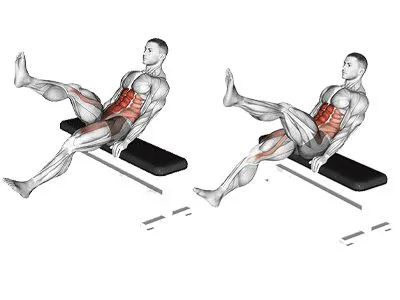
- Pros: Great for beginners, simple to use, and versatile for various exercises.
- Cons: Limited ability to target different areas of your core.
- Best For: Basic ab exercises such as crunches and leg raises.
2. Incline Bench

- Pros: Elevates your torso, increasing the range of motion for exercises like crunches and sit-ups.
- Cons: May be too challenging for beginners if set to a steep angle.
- Best For: Targeting the upper abs and enhancing the intensity of crunches.
3. Decline Bench

- Pros: Provides a steep angle that challenges the lower abs, making exercises like sit-ups more intense.
- Cons: May be too difficult for beginners to perform exercises with proper form.
- Best For: Targeting the lower abs and increasing the intensity of ab exercises.
4. Adjustable Bench

- Pros: Offers multiple incline and decline settings, making it versatile and customizable for different exercises.
- Cons: Takes up more space and can be pricier.
- Best For: Those who want variety and the ability to progress with their ab workouts.
Best Bench Ab Exercises
Now that you know which bench to use, let’s dive into the best bench ab exercises. We’ll cover exercises for beginners, intermediate users, and advanced athletes, so there’s something for everyone.
1. Bench Crunches
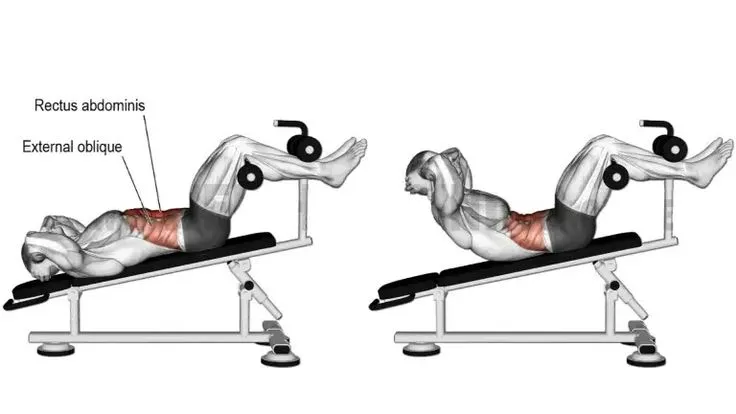
- How to Do It: Sit on the edge of the bench with your knees bent at a 90-degree angle. Lean back slightly and engage your core as you crunch forward.
- Target Muscles: Upper abs.
- Modification: For a greater challenge, increase the incline of the bench.
2. Decline Bench Sit-Ups
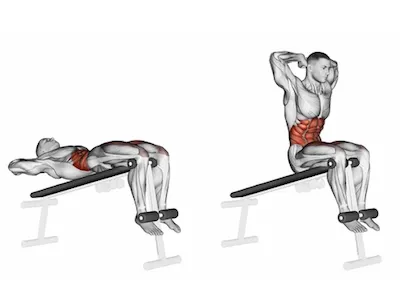
- How to Do It: Lie on a decline bench, with your feet anchored and your torso parallel to the floor. Use your abs to lift your torso towards your knees.
- Target Muscles: Lower abs.
- Modification: Perform the exercise without a weight plate for beginners.
3. Leg Raises on Bench
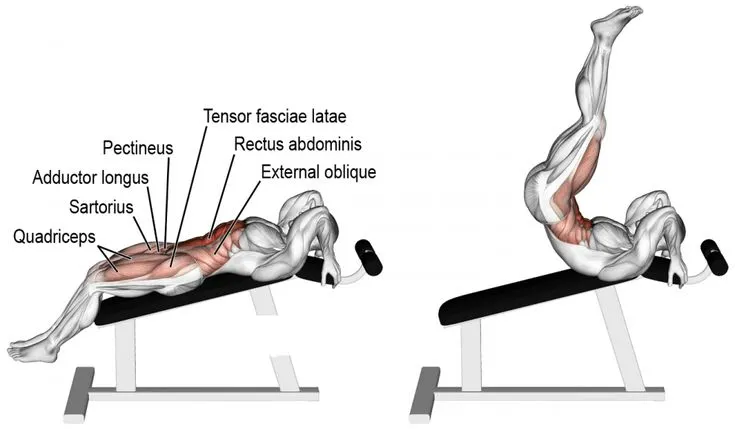
- How to Do It: Lie flat on the bench with your legs extended. Slowly raise your legs toward the ceiling, keeping your core engaged, and lower them back down without touching the floor.
- Target Muscles: Lower abs.
- Modification: Bend your knees if you’re a beginner.
4. Russian Twists with Bench Support
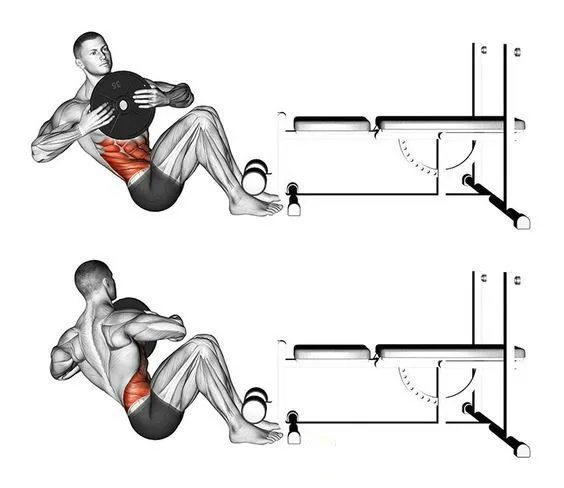
- How to Do It: Sit on the edge of the bench, leaning back slightly. Hold a weight or medicine ball and twist your torso from side to side.
- Target Muscles: Obliques and abs.
- Modification: Perform the exercise without weights to reduce difficulty.
5. Bench Leg Raises with Twist
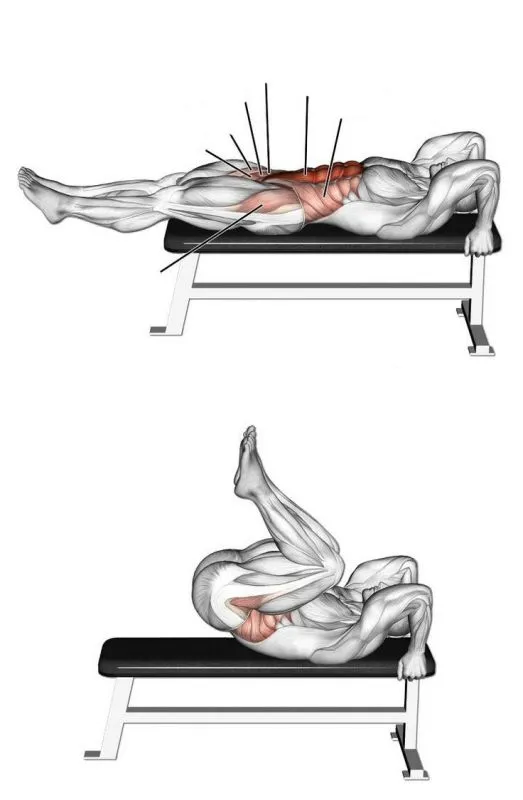
- How to Do It: Lie flat on the bench with your legs extended. Raise your legs while twisting your hips slightly to engage your obliques.
- Target Muscles: Lower abs and obliques.
- Modification: Keep your legs bent if you’re a beginner.
6. Bench V-Sit Crunch

- How to Do It: Sit on the bench with your legs extended in front of you. Lean back slightly and perform a crunch while simultaneously bringing your legs towards your chest.
- Target Muscles: Upper and lower abs.
- Modification: Keep your feet on the floor for a less challenging version.
7. Side Planks on Bench

- How to Do It: Place your forearm on a flat bench and extend your legs to the side. Hold a side plank position while keeping your hips raised.
- Target Muscles: Obliques.
- Modification: Drop your knees to the floor for extra support.
Sample Bench Ab Workouts for Different Fitness Levels
1. Bench Ab Workout for Beginners:
- 1 Set of Bench Crunches (15 reps)
- 1 Set of Leg Raises on Bench (10 reps)
- 1 Set of Russian Twists (15 reps per side)
- Repeat 2-3 times

2. Intermediate Bench Ab Workout:
- 3 Sets of Decline Bench Sit-Ups (15 reps)
- 3 Sets of Bench V-Sit Crunch (12 reps)
- 3 Sets of Leg Raises on Bench with Twist (10 reps per side)
- Repeat 3-4 times

3. Advanced Bench Ab Workout:
- 4 Sets of Decline Bench Sit-Ups with Weight (20 reps)
- 4 Sets of Russian Twists with Medicine Ball (20 reps per side)
- 4 Sets of Bench Leg Raises with Twist (15 reps per side)
- Repeat 4-5 times
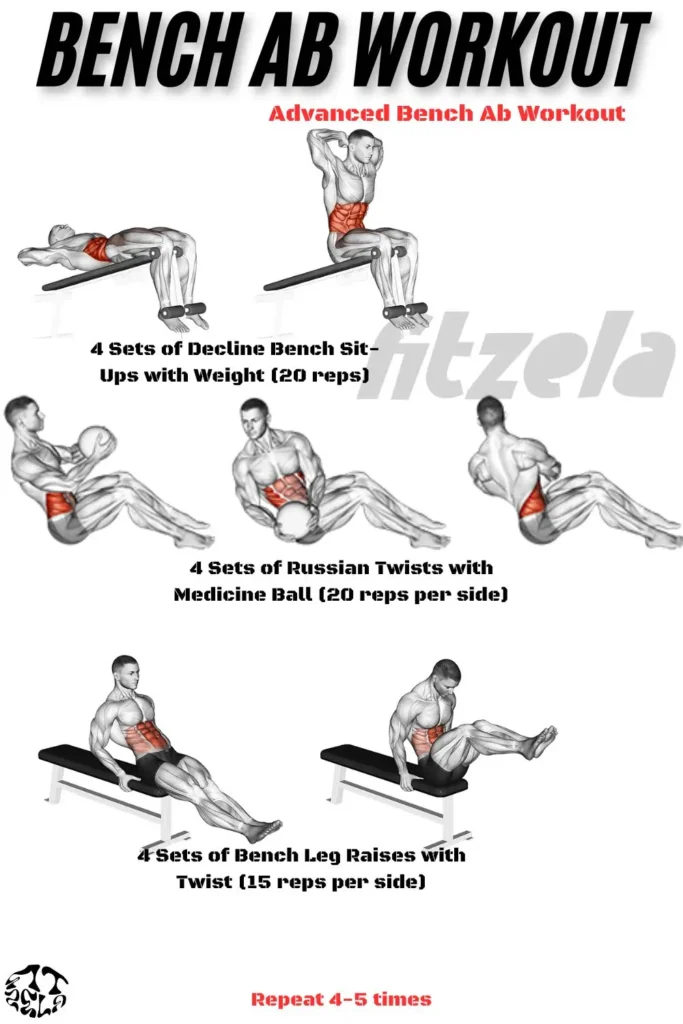
Tips for Proper Form and Technique
To maximize the effectiveness of your bench ab workout, it’s crucial to maintain proper form. Here are some tips to help you avoid common mistakes and stay injury-free:
- Engage Your Core: Keep your abs engaged throughout the exercise. This helps protect your lower back and ensures you’re targeting the right muscles.
- Controlled Movements: Perform each exercise slowly and deliberately. Rushing through exercises won’t engage your muscles effectively.
- Avoid Pulling on Your Neck: Never use your hands to pull on your neck or head during crunches or sit-ups. This can strain your neck muscles.
- Focus on Breathing: Exhale as you perform the movement and inhale as you return to the starting position. Proper breathing ensures you’re getting the most out of each rep.
Common Mistakes to Avoid
- Not Engaging the Core Properly: If you’re not actively engaging your abs, you may be putting undue pressure on your lower back.
- Using Momentum: Avoid swinging your legs or torso to complete the movement. This reduces the effectiveness of the exercise.
- Overextending the Spine: Always keep your spine in a neutral position to avoid injury. Don’t arch your back excessively during sit-ups or crunches.
Incorporating Bench Ab Workouts into Your Fitness Plan
Bench ab workouts should be part of a well-rounded fitness routine. Here’s how to incorporate them into your overall workout:
- Frequency: Perform bench ab exercises 2-3 times per week, allowing a day of rest in between to let your muscles recover.
- Full Body Routine: Combine your ab workouts with other strength training exercises to build muscle across your entire body. Include exercises like squats, deadlifts, and push-ups to balance your routine.
- Cardio and Nutrition: To reveal your abs, incorporate cardio into your routine (e.g., running, cycling) and follow a balanced diet. A healthy diet is crucial for reducing body fat and achieving visible abdominal muscles.
Nutrition Tips for Optimizing Ab Development
- Eat a Balanced Diet: Focus on whole foods like lean protein, vegetables, fruits, and whole grains to fuel your workouts and promote muscle growth.
- Stay Hydrated: Proper hydration is essential for muscle function and recovery.
- Reduce Processed Foods: Limit processed sugars and unhealthy fats that can contribute to fat gain.
FAQ: Bench Ab Workouts
Q: Can I get a six-pack with only bench ab workouts? A: While bench ab workouts can help build and tone your abdominal muscles, a six-pack is made visible by reducing body fat. Combine ab exercises with a healthy diet and cardio to see results.
Q: Are bench ab workouts suitable for beginners? A: Yes, bench ab workouts for beginners can be modified to suit your fitness level. Start with simpler exercises like bench crunches or leg raises, and gradually increase the intensity as you progress.
Q: How often should I do bench ab exercises? A: Aim to perform bench ab exercises 2-3 times per week, allowing for recovery between sessions.
Conclusion
Incorporating bench ab workouts into your routine can help you sculpt a strong, toned core. Whether you’re a beginner or an advanced athlete, the variety of exercises and bench types available make it easy to tailor your workout to your fitness level. Remember, achieving visible abs also requires a combination of proper nutrition and regular cardio. So, get on the bench, follow the workouts, and start building your six-pack today!



